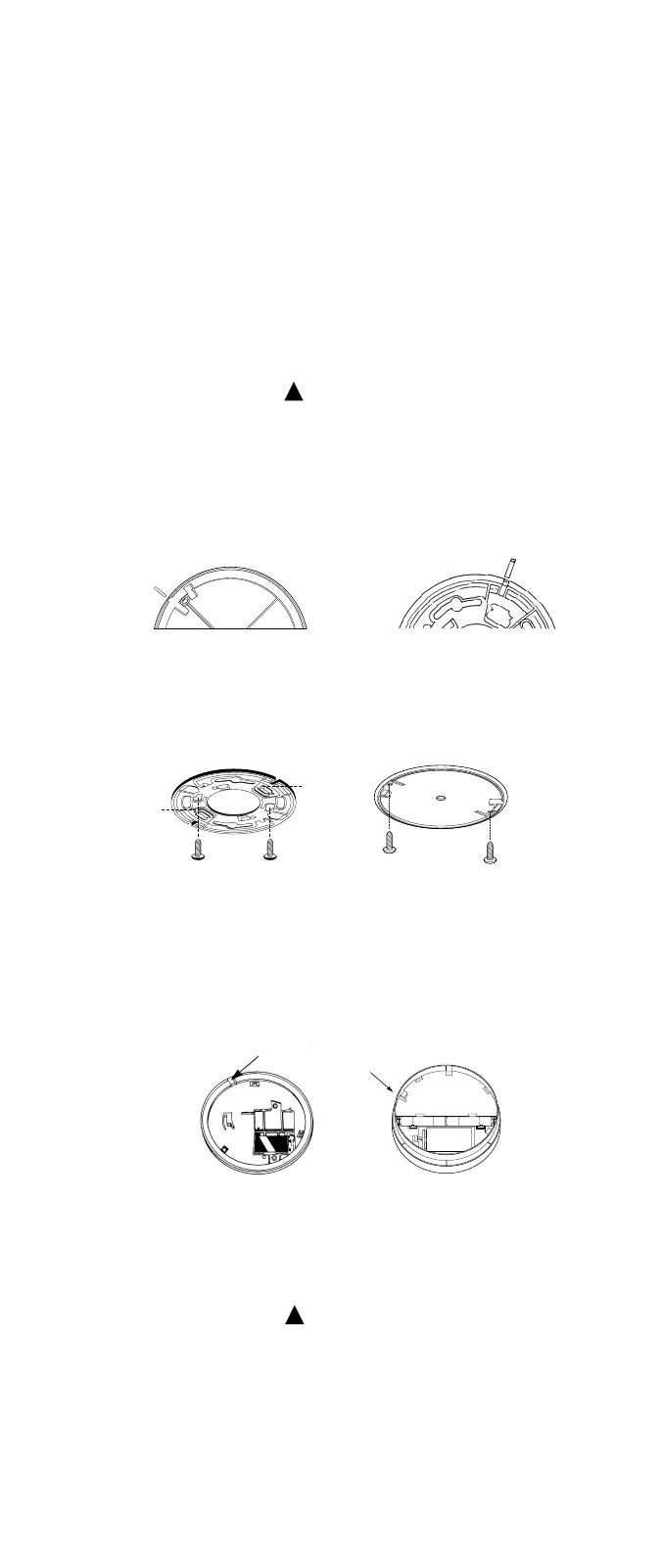
3
Additional Smoke Alarm Placement Information cont.
Install a smoke alarm as close to the center of the ceiling as possible. If this is not practical, mount no
closer than 4 inches from a wall or corner. Also, if local codes allow wall mounting, install smoke alarms
on walls between 4 and 12 inches from ceiling/wall intersections.
Install a smoke alarm in each room that is divided by a partial wall (either coming down from the ceiling
at least 24 inches, or coming up from the floor).
Install smoke alarms on peaked, cathedral, or gabled ceilings, at or within 3 feet from the highest point
(measured horizontally).
Install a smoke alarm in lived-in attics or attics which house electrical equipment like furnaces, air condi-
tioners, or heaters.
DO NOT Install Smoke Alarms:
In areas where combustion particles are present. (Combustion particles are the by-products of something
that is burning.) Areas to avoid include poorly ventilated kitchens, garages, near furnaces, or near hot water heaters. Place
smoke alarm as far from the source of combustion particles as possible to prevent nuisance alarms.
In damp or very humid areas such as bathrooms with showers where normal humidity may rise above 93% relative
humidity. Areas above this humidity level can cause a false alarm.
In direct air flow nor within 3 feet of heating and cooling supply vents. Install at least 3 feet (0.9
meters) away from these areas. The air could blow smoke away from the detector, interrupting its alarm.
In rooms where temperatures may fall below 40°F (4°C) or rise above 100°F (38°C).
In extremely dusty, dirty, or insect-infested areas. Loose particles interfere with smoke alarm operation.
How to Install Your Smoke Alarm
This smoke alarm is shipped with the battery disconnected. You MUST properly
connect the battery before mounting the smoke alarm to the wall or ceiling. The
smoke alarm will not operate without the battery first being properly connected.
Read SMOKE ALARM PLACEMENT information on pages 3-4. After you have
selected the locations for the installation of smoke alarms:
1.
Unlock and remove mounting plate by turning it counter-clockwise. (For tamper-resist option, twist out
and set aside the locking pin molded into the plastic mounting bracket. For Model CEC and CCPB the
locking pin is molded into the plastic base.)
2. Place mounting bracket against ceiling or wall where you wish to mount the smoke alarm. Use a pen-
cil to trace the inside of the two mounting hole locations.
3. Drill two holes, using a 3/16 in. (5 mm) drill bit in the centers of the hole locations and insert anchors
into holes.
4. Use mounting screws to secure mounting bracket to ceiling or wall.
5. Lift open battery pocket door (Models CB, CC and CPBC only).
6. Connect new 9-volt battery to battery connector inside battery pocket. BE SURE BATTERY IS
SECURELY CONNECTED. Smoke alarm may beep briefly when battery is installed. Firmly depress
the test button for five (5) seconds [ten (10) seconds for Model CCPB]. The smoke alarm should
sound its alarm horn, indicating the battery is connected properly. Units with the Alarm Control
(Quick-Quiet
™
) feature will activate the Alarm Control (Quick-Quiet
™
) mode for a maximum of 15 min-
utes after testing.
7. Insert battery into battery pocket.
8. Close battery pocket door, snapping it into place (Models CB, CC and CPBC only). (For tamper
resist, use long-nosed pliers to remove thin plastic from notch on smoke alarm edge.)
9. For model CEC install two AA batteries to power the light. Insert the batteries end-to-end into the
battery pocket, observing polarity.
10. Position smoke alarm to mounting bracket and turn clockwise. The smoke alarm will lock into place.
(To engage tamper-resist feature, insert pin into notch on edge of smoke alarm and mounting plate.)
NOTE: Smoke alarm will not mount to bracket if battery is not installed.
11. Test smoke alarm. See TESTING YOUR SMOKE ALARM.
DO NOT connect this smoke alarm to any other detector or electrical device.
Doing so will cause the smoke alarm to operate improperly or fail to operate.
Testing Your Smoke Alarm
If alarm horn sounds, and smoke alarm is not being tested, the smoke alarm is
sensing smoke. THE SOUND OF THE ALARM HORN REQUIRES YOUR IMMEDIATE
ATTENTION AND ACTION.
Test each smoke alarm weekly to be sure it is installed correctly and operating properly.
Test smoke alarms upon returning from vacation. Also test when no one has been in the household for
several days.
Stand at arm’s length from the smoke alarm when testing. The alarm horn is loud to alert you to an
emergency. The alarm horn may be harmful to your hearing.
WARNING
!
WARNING
!
Insert pin here
Insert pin here
Remove thin plastic from notch
110-1011E English 12/12/06 10:10 AM Page 3








